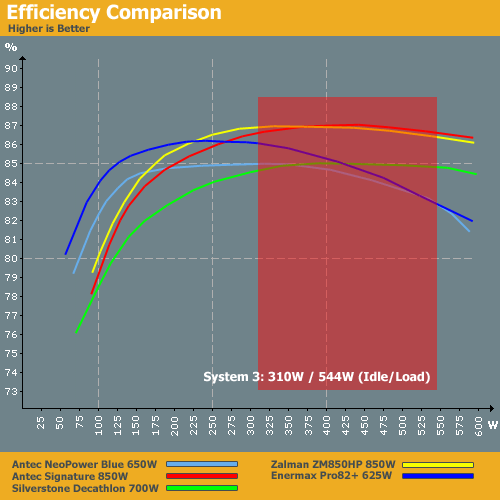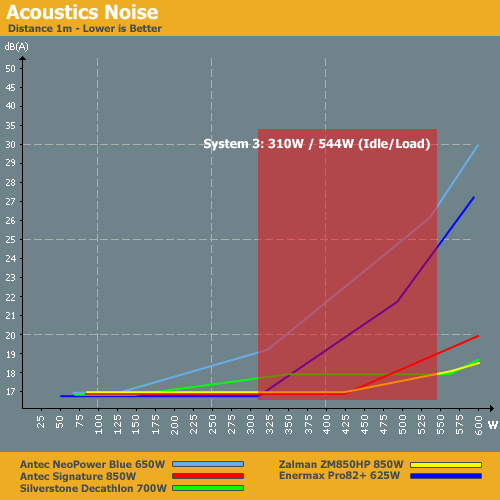Debunking Power Supply Myths
by Christoph Katzer on September 22, 2008 3:00 AM EST- Posted in
- Cases/Cooling/PSUs
PSUs for High-End Systems
Even though our high-end system consumes more power, we used the same graph layout. That means the resulting graphs stop at 600W, despite the high-end PSUs all being capable of providing more power than that. Our high-end system sports an SLI setup using two NVIDIA 8800 ultra cards; 3-way SLI would be a bit more demanding, but we don't feel it's a good indication of what people are actually running. The third card would also only add another 50W to 90W of power consumption to our system, since the third card is rarely taxed as much as the first GPU.
- Antec NeoPower Blue (650W) actively cooled
- Antec Signature (850W) actively cooled
- Silverstone Decathlon (700W) actively cooled
- Zalman ZM850HP (850W) actively cooled
- Enermax Pro82+ (625W) actively cooled

We've included the Enermax Pro82+ 625W from the midrange selection as well. Again, efficiency is not the major issue when it comes to choosing between these products. The two lowest rated power supplies -- Antec NeoPower 650W and Enermax Pro82+ 625W -- are less efficient over the tested range, but that's expected. The results all of her around 85% to 87% mark, and one or 2% difference really isn't going to matter much. Still, the Zalman and Antec 850W units place at the top of this chart.

Again, the two power supplies with the lowest output rating perform worse in this test, generating much more noise than the competition. The higher rated units don't have to work as hard, since they are running at a medium load. Those three PSUs remain very quiet along with providing better efficiency, making them the better for a high-end setup. The Zalman and Antec Signature 850W units would be our choice, if only for the extra headroom. Either PSU would have no difficulty with a 3-way GPU setup, provided you have sufficient PEG connections available. That brings up the next topic of discussion.










98 Comments
View All Comments
JarredWalton - Monday, September 22, 2008 - link
Edit: Christoph's text reflect the range for 90VAC to 230VAC, but my editing made that a little less clear. I've added in "input voltage" comments to clarify things.poohbear - Monday, September 22, 2008 - link
thanks for this article!!! im planning on running 2 8800gt's in SLI on a 80% efficient enermax 420wt psu. it has 29a on the 12v+ line so im confident it can run it. All this BS about needing 500+wts psus is nonsense if you know your cards power needs.bela - Monday, September 22, 2008 - link
Where did you get those power figures? Dream last night or what?This is totally made up bullshit.
The ANTI-AMD war continues @ Anandtech
you compare 2 year old 90nm AMD DC with new 45nm Intel DC, is that a fair peer group?
6000+ 160W load? Even with 90nm this ist ridicoulus, it should be around 110W, a new 65nm 6000+ needs less then 80 Watt, a 65nm 5000+ less then 60W, so talk about making Intel look good.
elaar - Monday, September 22, 2008 - link
bela, you seem to be incredibly rude and have also missed the entire point of the article, if it makes you that annoyed then why not do us all a favour and stop reading articles and commenting in the future.I for one found the article incredibly useful especially when you consider the sheer number of people who go out and buy way too powerful psu's and have no idea what they're doing.
It doesn't matter what processor or graphics cards power stats were listed, they were just there as examples for the article, god knows how you've managed to get so confused with paranoia to believe it was an anti AMD campaign.
Thanks Anandtech for a superb article.
npp - Monday, September 22, 2008 - link
The power draw figures for the X2 6000+ are a bit off-scale (and yes, it is an older 90nm die, apparently), it's a tiny bit, however. You can have a look at the charts here (damn, the stupid link button doesn't work):http://xbitlabs.com/articles/cpu/display/dualcore-...">http://xbitlabs.com/articles/cpu/display/dualcore-...
The system equiped with an X2 6000+ was measured to draw about 304W at full load and 180W at idle. Adding ~25W to that difference makes for ~150 total power consumption, which comes close to what was stated in the article. Just because you thought "it should be around 110W" doesn't make you automaticaly right. Learn living with the truth and stop behaving like a small child.
Furthermore, as it was properly stated, those figures were intended to draw a frame around the best and worst case scenarios, representing some of the CPUs typicaly found in a system today. They weren't meant as a CPU-to-CPU comparison.
That old dark sense of anti-AMD or anti-Intel paranoia continues to be abundant in every discussion nowadays... What a triumph for the PR brainwashers at both camps.
bela - Friday, September 26, 2008 - link
No, they are not of scale, they are bullshit, nothing else but made up numbers.Look at this:
X2 6400+ WITH Voltage Regulator, depending on Board 85,9 or 103,3 Watt
http://ht4u.net/reviews/2008/amd_phenom_leistungsa...">http://ht4u.net/reviews/2008/amd_phenom_leistungsa...
This ist the truth, nothing else
Kiijibari - Monday, September 22, 2008 - link
Could this be a typo ?106W is ok, 160W is a little bit out of the "normal" scale ..
Furthermore .. which 6000+ is it ?
There are 3 different models:
one 90nm "normal" model: 125W 3,0 GHz; 2x1MB L2 (ADX6000IAA6CZ)
one 90nm EE model: 89W 3,0 GHz; 2x1MB L2 (ADA6000IAA6CZ)
one 65nm model: 89W 3,1 GHz; 2x512kB L2 Cache (ADV6000IAA5DO)
cheers
Kiiji
JPForums - Monday, September 22, 2008 - link
This is a curiosity for me as well.I have an A64 X2 6400+ 125W, 3.2GHz, 2x1MB L2 (don't remember the model number off hand) that doesn't seem to require near that power.
The 6400+ is running on an nForce 570SLI with 8Gb (4x2Gb) DDR2-800.
The video card is an 8800GTS 512Mb.
I have 4 HDDs 2 optical drives and 8 fans (7 case + CPU fan) that according to specifications run at 8.6W when at full speed (how I have them while gaming).
If I use the (presumably lower) power ratings used for the 6000+ and the 8800GT, and I exclude the power of usb components and the fan controller/sensor overhead, my total system consumption at load (using the values from the article) is around 450W.
The curiosity is that the same Enermax Pro82+ 385W PSU mentioned in the article has no issue running this system. (Ironically emphasizing the point of the article) Using a basic kill-a-watt meter, I found a power draw of 378.2 was as high as it got during benchmarking, gaming, stressing the system. For reference, I tried 3DMarks 2006/Vantage, Stalker, Crysis, C&C3, and a combination of 2xPrime95 + ATItool's GPU heat up mode (rotating fuzzy block). The ATI tool combo offered the largest power draw in my system. Granted, the kill-a-watt may not be as accurate and I may not have stressed the system as well as in the article, but I suspect the power draw numbers for the 6000+ are lower than the article suggests.
That small inconsistency aside, this was a nice article. I would like to see those power draw blocks that you overlayed on the power efficiency and noise curves included in future PSU reviews. It would be a quick and easy way to let people know how applicable the PSU being reviewed is to them. It would also be interesting to see how high the power draw gets with water cooling systems, case mods (I.E. cold cathodes), and the likes.
Christoph Katzer - Monday, September 22, 2008 - link
My 6000+ was 90nm, yours?Kiijibari - Monday, September 22, 2008 - link
He has a 6400+, that CPU is 90nm only (so far).But he has a AM2 mainboard, maybe you had a AM2+ board, and the onboard VRMs are running badly with a AM2 CPU ?
cheers
Kiiji